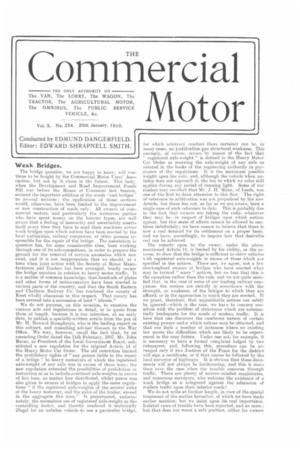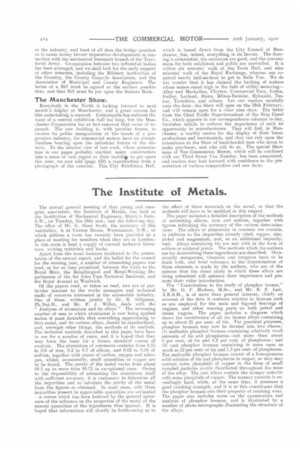Weak Bridges.
Page 1

Page 2

If you've noticed an error in this article please click here to report it so we can fix it.
The bridge question, we are happy to know, will continue to be fought by the Commercial Motor Users' Association, lint not by it alone in the future. This body, when the Development and Road Improvement Funds Bill was before the House of Commons last Session, secured the important addition of the words "and bridges.' to several sections; the application of those sections would, otherwise, have been limited to the improvement or new construction of roads only. All owners of commercial motors, and particularly the numerous parties who have spent money on the heavier types, are well aware that a feeling of insecurity and uncertainty asserts itself every time they have to send their machines acmes weak bridges upon which notices have been erected by the local authorities, railway companies, or other persons responsible for the repair of the bridge. The association in question has, for some considerable time, been working through one of its sub-committees, in order to prepare the ground for the removal of certain anomalies which now exist, and it is not inappropriate that we should, at a time when joint action with the Society of Motor Manufacturers and Traders has been arranged, briefly review the bridge question in relation to heavy motor traffic. It is a matter of common knowledge, that hundreds of plates and other forms of notice-carriers have been erected in various parts of the country, and that the South Eastern and Chatham Railway Co. has rendered the county of Kent wholly obnoxious in this respect. That county has been severed into a succession of land " islands."
We do not purpose, on this occasion, to examine the various acts and regulations in detail, or to quote from them at length. because it is bur intention, at an early date, to publish a specially-written article from the pen of Mr. H. Howard 'Humphreys, who is the leading expert on this subject, and consulting adviser thereon to the War Office. We may, however, recall the fact that, by an amending Order dated the 11th February, 1907, Mr. John Burns, as President of the Local Government Board, substituted a new regulation for the original Article 14 of the Heavy Motor Car Order. The old restriction limited the prohibitory rights of "any person liable to the repair of a bridge " to heavy motorcars of which the registered axle-weight of any axle was in excess of three tons; the new regulation extended the possibilities of prohibition or restriction se as to include combined axle-weights in excess of five tons, no matter how distributed, whilst power was also given to owners of bridges to apply the same regulations " if the registered a-ale-weights of the several axles of the heavy motorcar, and the axles of the trailer, exceed in the aggregate ffve tons." It perpetuated, unfortunately, the anomalous use of registered. axle-weight as the controlling factor, and thereby rendered it technically illegal for an unladen vehicle to use a particular bridge, for which arbitrary conduct there certainly can be in many eases, no justification qua structural weakness. This anomaly, of course, occurs by reason of the fact that " registered axle-weight "is defined in the Heavy Motor Car Order as meaning the axle-weight of any axle as entered in the books of the registering authority in pursuance of the regulations. It is the maximum possible weight upon the axle, and, although the vehiclewhen unladen does not approach it, the bar to which we refer still applies during any period of running light. Some of our readers MY' recollect that Mr. J. H. Mann, of Leeds, was one of the first to draw attention to this flaw. The right of reference to arbitration was net prejudiced by the new Article, but there has not, so far as we are aware, been a single case of such reference to date. This is probably due to the fact that owners are taking the risks—whatever they may be in respect of bridges upon which notices appear, but this state of affairs cannot be allowed to effiltin ue indefinitely; we have reason to believe that there is now a real demend for its settlement on a proper basis, and we have, accordingly, to inquire how that desirable end can he achieved.
The remedy open to the owner, under the aforementioned Article 14, is limited by his ability, or the reverse, to show that the bridge is sufficient to carry vehicles
ith registered axle-weights in excels of those which are specified in the notices. There are, we agree, not a few short-sighted owners of bridges who have erected what may be termed " scare " notices, but we fear that this is the exception rather than the rule, and we are quite satisfied that, in the case of some of our leading railway corn': an es, the notices are strictly in accord a n co with the strength, or weakness, of the bridges to which they are affixed, or in the approaches to which they are erected. If we grant, therefore, that unjustifiable notices can safely be ignored—which is the ease, we have to concern ourselves with the problem of structures which are substantially inadequate for the needs of modern traffic, It is here that one discovers the cumbrous nature of certain existing powers under which redness may be obtained, and that one finds a number of instances where no existing law meets the difficulties which are likely to be experienced in the near future. Under one act, for example, it is necessary to have a formal complaint lodged by two ratepayers, and, following this, procedure can be arrenged only if two Justices of the Peace for the district will sign a certificate, or if that course be followed by the local surveyor of highways. It is obvious that these documents will not always be forthcoming, and this is more than ever the ease when the trouble concerns through traffic. There are plenty of narrow-minded magistrates, and numerous surveyors, who welcome the existence of a weak bridge as a safeguard against the admission of modern traffic upon their inferior roads! We do not write at, further length, in view of the special treatment of the matter hereafter, of which we have made earlier mention, but we insist upon its real importance. leoIated cases of trouble have been reported, and no more ; but that does not mean a safe position, either for cwners
or the industry, and least of all does the bridge question as it exists to-day favour imperative developments in connection with the mechanical transport branch of the Territorial Army. Co-operation between two influential bodies has been arranged, and we shall look for the early support of other interests, including the Military Authorities of the Country, the County Councils Association, and the Association of Municipal and County Engineers. The terms of a Bill must be agreed at the earliest possible date, and that Bill must be put upon the Statute Book.
The Manchester Show.
Everybody in the North is looking forward to next month's display at Manchester, and a great success for this undertaking is assured. Cottonopolis has endured the want of a central exhibition hall too long, hut the Manchester Corporation has at last removed that cause of 'reproach. The new building is, with peculiar fitness, to receive its public inauguration at the hands of a progressive industry, for commercial motors have an a Imostlimitless bearing upon the industrial future of the district. To the interior view of last. week, whose presentation in our pages probably startled many constructors into a sense of vain regret at their inabiliit to get space this year, we now add (page 422) a. reproduction from a photograph of the exterior. This City Exhibition Hall, which is leased direct from the City Council of Manchester, has, indeed, everything in its favour. The flooring is substantial, the entrances are good, and the conveniences for both exhibitors and public are unrivalled. It is within six minutes' walk of the Town Hall, and nine minutes' walk of the Royal Exchange, whereas one required nearly half-an-hour to get to Belle Vile. We do not Is-ander that it has claimed the backing of makers whose names stand high in the field of utility motoring— Alley and MacLellan, Clayton. Commercial Cars, Foden, Halley, Leyland, Mann, Milnes-Daimler, Ryknield, Tasker, Yorkshire, and others. Let our readers carefully note the date: the Show will open on the 18th February, and will remain open for a clear nine days. The letter from the Chief Traffic Superintendent of the Ship Canal Co., which appears in our correspondence columns to-day, furnishes details to enforce the importance of such an opportunity to manufacturers. They will find, in Manchester, a worthy centre for the display of their latest productions and testimonials, and they can rely upon the attendance at the Show of hard-headed men who mean to make purchases, and who will do so. The special Show issue of THE COMMERCIAL MOTOR, which will be combined with our Third Great Van Number, has been announced, and readers may look forward with confidence to the presentation of various comparative and new facts.






















